[p.367]
Deshays
Deshays is unquestionably the greatest church painter we have. Vien is not his strength in this genre, and Carle Vanloo has given way to him; there is, however, de Vien a certain Piscine1...
I do not balance to pronounce that Le Mariage de la Vierge2 is the most beautiful composition there is at the Salon, as it is the most vast. This painting is nineteen feet high and eleven feet wide. The space is immense, and everything responds to it.
[p.368] On the right we see the altar and the seven-branched candelabra. The high priest stands at the top of the steps, his back to the altar and his face toward the bride and groom. His arms are outstretched and his head raised to heaven. He invokes its assistance. He is majestic. He is tall. He is imposing; he is full of enthusiasm. The bride and groom kneel on the last steps. The noble, tall, modest Virgin, dressed and draped naturally, in Raphael's true taste. The bridegroom, who may be forty-five, is vigorous and fresh. He presents his bride with the wedding ring. His character says neither too much nor too little. Behind the bridegroom is a Saint Anne, whose wrinkled face is the image of joy. Next to Saint Anne, behind the Virgin, is a tall girl, beautiful, simple, innocent, a veil thrown carelessly over her head, the rest of her body covered with a long drapery, and carrying a basket of roses; it's only an accessory, but one we never tire of looking at. To the right of the high priest and the altar, the painter has cast a group of assistants, witnesses to the ceremony; their eyes are fixed on the bride and groom. To the left of the high priest, and at the front of the picture, he has placed two Levites dressed in white, quite in the manner of Le Sueur. One holds flowers, the other leans on a torch. O the two beautiful figures! There are some difficult people who, agreeing on their merit and the beauty of their character, claim that they are a little contoured, and that the painter has squeezed the thighs of one with a wide band without really knowing why. Woe betide these people, they'll never be satisfied with anything! They also say that the glory3 that fills the top of the painting is a little heavy, and we have to grant them this point, especially as the glow they desire there would not have extinguished the rest of a very strongly painted composition. As for these grouped angels, they cannot deny their lightness; they are suspended in mid-air, and we are not surprised that they remain there. The more you look at this piece, the more it strikes you. The color is strong, and more [p.369] perhaps than true. The painter has not yet done anything, in my opinion, either so beautiful or so bold ; I except neither his Saint Benoît4, from the past Salon, nor his Saint Victor5, nor his other martyr6 whose name does not come to me, though there was both strength and genius.
Let it be said after this that our mythology lends itself less to painting than that of the Ancients7. Perhaps Fable offers more gentle and pleasant subjects; perhaps we have nothing to compare, in this genre, with the Judgment of Pâris8; but the blood that the abominable cross has spilled on all sides is a very different resource for the tragic brush. No doubt there is sublimity in a head of Jupiter; it took genius to find the character of an Eumenides9, as the Ancients left it to us; but what are these isolated figures compared to scenes of alienation of spirit or religious firmness, the atrocity of intolerance, an altar smoking incense before an idol, a priest coldly sharpening his knives, a praetor having his fellow man torn apart in cold blood with a whip, a madman gleefully offering himself to all the torments shown to him and defying his tormentors, a frightened people, children averting their eyes and toppling over onto their mothers' bosoms, lictors dismissing the crowd, in a word, all the incidents of these kinds of spectacles10? The crimes that Christ's madness has committed and caused to be committed are all great dramas, and far more difficult than Orpheus' descent into hell, the charms of Elysium, the torments of the Tenare or the delights of Paphos. In another genre, consider all that Raphael and other great masters have drawn from Moses, the prophets and the evangelists. Is it a barren field for genius that Adam, Eve, her family, Jacob's posterity and all the details of patriarchal life11? As for our paradise, I confess it's as flat as those who inhabit it and the happiness they taste there. There's no comparison between our sadly ecstatic saints, apostles and Virgins, and those Olympian banquets where the nervous Hercules, leaning on his club, gazes lovingly [p.370] the delicate Hebe, where Apollo with his divine head and long hair, holds, by his chords, the enchanted guests ; where the master of the gods, intoxicated by a nectar poured full cup from the hand of a young boy with ivory shoulders and alabaster thighs12, makes his jealous wife's heart swell with spite. Without question, I'd rather see Venus's rump, throat and beautiful arms than the mysterious triangle13; but where, in there, is the tragic subject I'm looking for? The talent of the Racines, the Corneilles and the Voltaires requires crimes, and no religion has ever been as fertile in crimes as Christianity. From the murder of Abel to the ordeal of Calas, not a single line of its history is without bloodshed. Crime is a beautiful thing, both in history and in poetry, on canvas and in marble. I sketch, my friend, with the current of the pen. I throw out seeds that I leave to the fertility of your head to develop.
It's an idea I've had for a long time, that if the religion of the Greeks was more favorable to poetry, ours on the other hand is far more picturesque. The passions that fanaticism inspires and that enthusiasm accompanies are the most worthy of a sublime brush, and our cult is teeming with these kinds of subjects. I don't agree with the philosopher on the subjects provided by the historical part of our sacred books, and I find that on this point the advantage lies entirely with Greek mythology. The details of patriarchal life may suggest some fine landscape paintings, but the Idylls of Theocritus and Gessner will make for equally interesting ones. As for the historical subjects taken from the Old and New Testaments, I confess that they have simplicity, and that nannies can make good enough tales from them for children's amusement; but they almost all lack nobility, poetry and grace, and have an air of poverty and meanness about them that only habit can deceive us. What a difference between the story of the Virgin and that of the Mother of Love! I'll take my turn at blasphemy with the painting of the Marriage of the Virgin. It's easily the first painting in the Salon. It's a big, beautiful machine, but it seems to me that I've seen more sublime ones in this genre. The Carracci, the Tintoretto and the Dominiquin spoil French paintings when you remember them. Deshays' Virgin is fine, very fine, but if I dared, I'd say that the good man Joseph looks as if he's saying to her: "Come on, don't be such a baby"; I'd say that the Saint Anne is so sunken that she doesn't look at all like a mother, but like a very subordinate figure; I'd say that I'd like the high priest to look enthusiastic, rather in the character of his head than in his gestures. Besides, my pastor, M Baer, chaplain to the Royal Chapel of Sweden, pointed out to me some terrible blunders against costume in this painting.
He assured me that the Jews did not celebrate their weddings in front of an altar, nor with lighted candles as if one were going to say mass; but only a heretical pastor could raise such faults, and Catholic priests are too ignorant to be shocked by them. But let the good Catholic Diderot continue his career14.
Joseph's Chastity.
Here's a machine15 not as great as the previous one, but which hardly yields to it in merit, and which comes in support of my digression. It is La Chastity of Joseph16.
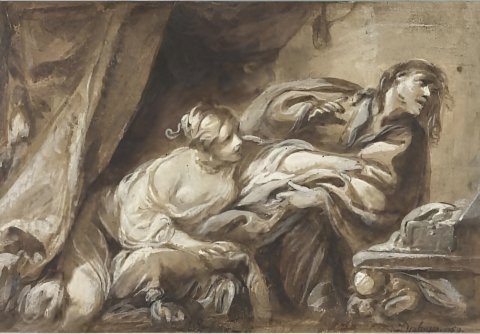
I don't know if this painting is intended for a church; but it's to damn the priest in the middle of his mass, and give all the attendants to the devil. Have you seen anything more voluptuous? I do not even exclude this Madeleine by the Correge17 from the Dresden gallery, whose print you preserve with such care for the mortification of your senses.
Putiphar's wife has rushed from the bedside to the foot of his bed. She lies on her stomach, and stops by the arm the foolish, handsome slave for whom she has taken a liking. We see her throat18 and shoulders. What a beautiful throat! How beautiful those shoulders are! Love and spite, but even more spite than love, show on her face. The [p.371] painter has spread features that, without disfiguring her, reveal impudence and wickedness. When one has taken a good look at her, one is surprised neither by her action nor by the rest of her story19. Joseph, however, is in inexpressible turmoil. He doesn't know whether to flee or stay20. His eyes are turned skyward. He's calling on it for help. This is the image of agony21 at its most violent. Deshays was careful not to22 give her that indignant, fierce air so unsuited to a gallant man whom a charming woman warns23. It's perhaps a little less chaste than in the holy book; but it's infinitely more interesting. Isn't it true that you like him better uncertain and perplexed, and that you put yourself in his place much more easily? When I return to the Salon24, I always hope to find him in the arms of his mistress. This woman has a bare leg that descends out of bed. O the admirable halftone there! We can't say that her thigh is uncovered ; but there's such magic25 in that light linen that hides it, or rather that shows it26 that there is no woman who does not blush, no man whose heart does not palpitate. If Joseph had been placed on this side, his chastity would have been over. Either the grace27 he was invoking would not have come, or it would have come only to excite his remorse. A thick, green-backed, flowered cloth, strong and fluffy, descends in wide, straight folds and covers the bedside.
If I'm given a painting to choose from at the Salon, here's mine; look for yours. You'll find more skilful ones, more perfect ones perhaps; for a more seductive one, I defy you. Perhaps you'll tell me that the woman's head isn't very correct; that Joseph's isn't young enough; that the red carpet that covers this bit of toilet is hard28; that this yellow drapery on which the woman has one of her hands pressed, is raw, imitates bark, and hurts your delicate eyes? I scoff at all your observations and stick to my choice.
[p.372] And then one more little digression29...
A moment, please, Mr. Philosopher. You'll laugh at me, if you like; but I couldn't live with your Joseph. Don't you see that he's forty years old, and that the painter has given him the benign, suffering air of a saint? It's not that. I assure you that the slave whom Putiphar's wife wanted to shower with her good graces was a child of eighteen, handsome as Love, brilliant as the star of the day. I assure you that the irresolute, perplexed air cannot fail to make him comical, and that the only character that suits him is that of innocence and fright at the sight of the dangers his virtue runs; the painter must show me in the whole figure of the beautiful slave that he fears less the charms of the most seductive woman in the world than the weakness of his own heart; he must be frightened of it. This is the truth of the moment he has chosen. Despite this, I agree that Deshays' painting is superb, the woman is head-turning; but agree for your part that if the beauty and expression of the slave were worthy of the desires of her beautiful mistress this painting would have no equal for charm, seduction and voluptuousness. If you believe me, my friend, we'll forget about this beautiful woman who won't grab your coat or mine, and we'll listen to your digression, which seems very learned to me.
And then one more little digression, please. I'm in my study, from where I have to see all these paintings30. This contention tires me, and digression rests me.
Jumble together objects of every kind and color, linen, fruit, liquor, paper, books, cloth and animals, and you will see that air and light, those two harmonic31 universals, will tune them all, I don't know how, by imperceptible reflections. Everything will bind together; disparities will weaken and your eye will reproach nothing of the whole. The art of the musician who, by touching the perfect C chord on the organ, brings to your ear the dissonant C, E, G, C, G#, B, D, C, has come this far; that of the painter will never come this far. This is because the musician sends you the sounds themselves, and what the painter grinds on his palette is not flesh, blood, wool, sunlight, air from the atmosphere, but earth, plant juices, calcined bones, crushed stones, metallic limes32. Hence the impossibility of rendering the imperceptible reflections of objects on each other; for him, there are enemy colors that will never be reconciled. Hence the particular palette, a technique specific to each painter33. What is this technique? The art of saving a certain amount of dissonance, of dodging difficulties superior to art. I challenge the boldest among them to suspend the sun or moon in the middle of his composition, without offending these two stars or vapors or clouds; I challenge him to choose his sky, such as it is in nature, studded with bright stars as in [p.373]the most serene night. Hence the need for a certain choice of objects and colors. Even after this choice, however well made it may be, the best, most harmonious picture is no more than a tissue of falsities that cover each other. Some objects win, others lose, and the great magic consists in getting close to nature, and making everything lose or win proportionally. But then it's no longer the real, true scene that we see; it's, so to speak, only a translation of it. Hence the hundred-to-one wager that a painting whose arrangement is rigorously prescribed to the artist will be a bad one, because it's tacitly asking him to suddenly form a new palette. In this respect, painting is like drama. The poet arranges his subject in relation to the scenes for which he feels he has talent, and from which he believes he will benefit. Racine would never have filled the canvas34 of Horaces ; Corneille would never have filled the canvas of Phedre.
I still feel weary. So let us follow this digression for a moment longer. I will not speak to you of the brilliance of the sun and moon, which it is impossible to render; nor of that fluid interposed between our eyes and these stars which prevents their limits from cutting hard against the space or background to which we report them, a fluid which it is no more possible to render than the brilliance of these luminous bodies. But I ask you, isn't their rigorous, spherical outline unpleasant? Wouldn't they look like blobs, no matter how brilliant the artist made them? It's impossible for a tree, such as a cherry tree, laden with red fruit, to make a good effect in a painting; and a space of the most beautiful blue, pierced with small luminous holes, will be just as sullen. I may be speaking blasphemy, but what do I care? Am I ashamed of being stupid with my friend? It's just that, in my opinion, it's not by its color, nor by the stars it sparkles with at night, that the firmament transports us with admiration. If, at the bottom of a well, you could see only a small circular portion of it, you would soon reconcile yourself with my idea. If a woman were to go to a silk merchant, and he were to offer her an a35 or two of firmament, I mean, fabric of the most beautiful blue and dotted [p.374] with brilliant points, I doubt very much if she would choose it to clothe herself in. So where does the transport that the firmament inspires in us during a serene starry night come from? If I'm not mistaken, it's from the immense space that surrounds us, the profound silence that reigns in this space and other incidental ideas, some of which have to do with astronomy and others with religion. When I say astronomy, I mean that popular astronomy which limits itself to knowing that these sparkling points are prodigious masses, relegated to prodigious distances, where they are the centers of an infinity of worlds suspended over our heads, and from which the globe we inhabit would be barely discernible. What a thrill it must be to imagine a Being creating all this enormous machinery, filling it, seeing us, hearing us, surrounding us, touching us! These, or I'm very much mistaken, are the main sources of our sensation at the appearance of the firmament; it's an effect that's half physical and half religious36.
But it's time to return to Deshays. There's a Resurrection of Lazarus, unnumbered and with no artist name37, attributed to him and certainly by him.
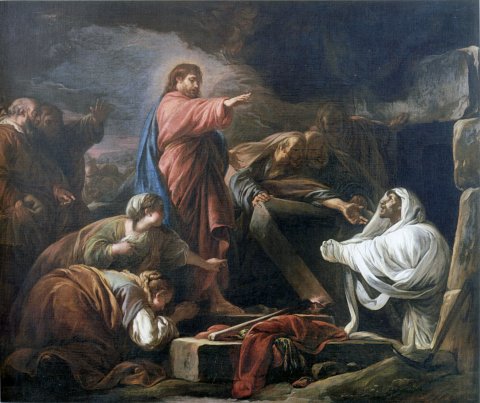
The tomb can be seen on the right. The risen man38 emerges standing, head uncovered. He reaches out to the God who gave him back his life, his arms still embarrassed by his shroud. His face is the image of death that the features of joy and gratitude have just animated. His parents, leaning towards him, stretch out their arms to him from the high place where they are standing. They are overcome with astonishment and joy. The artist has prostrated the two sisters at Christ's feet. One adores, face down; the other has seen the wonder. The expression, the drapery, the character of the head and the whole manner of this one is by Poussin39; this one is also very beautiful. The apostles are talking, some distance away, behind Christ. They are not as strongly affected as the rest of the attendants40; they are made for these tricks. Christ stands above the women, about equally distant [p.375] from the apostles and the tomb. He looks like a wizard in a bad mood. I don't know why, for his business has done him well. This is the main flaw in this painting, which can still be criticized for being a little raw in color and, as in the Marriage of the Virgin41, stronger than true.
But tell me, my friend, why is this Christ flat42 in almost every painting composition? Is this a traditional physiognomy from which it is not possible to deviate, and was Rubens wrong in his Elevation of the Cross43 to give it a grand and noble character?
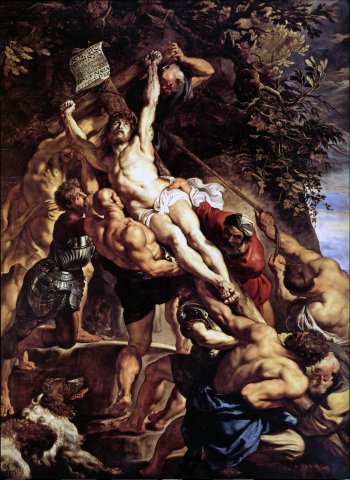
Tell me, too, why are all the resurrected ones hideous? It seems to me that it would be better not to do things by halves, and that it would cost no more to restore health with life. Take a look at this Lazare de Deshays. I assure you it will take him more than six months to recover from his resurrection.
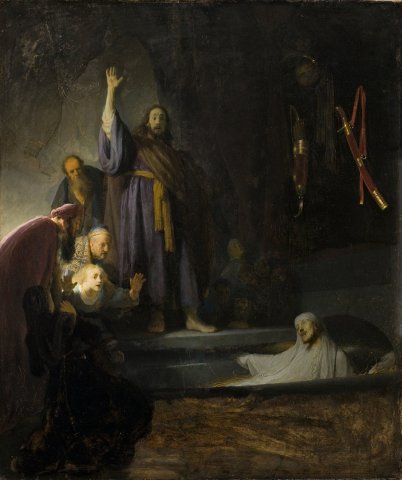
Joking aside, this piece is not without effect. The groups are well distributed. The Lazarus with his shroud is painted broadly. However, I wouldn't advise you to contrast it with Rembrand44 or Jouvenet. If you want to be amazed, go to Saint-Martin-des-Champs to see the same subject treated by Jouvenet45. What a life! What looks! What strength of expression! What joy! What recognition! An assistant lifts the veil covering this astonishing head and suddenly shows it to you. What a difference there is between those friends holding out their hands to Deshays' resurrected figure and that prostrate man shining a torch on Jouvenet's scene! Once you've seen it, you never forget it. Yet Deshays' idea is not without merit, no; his painting is small; but the manner is great.
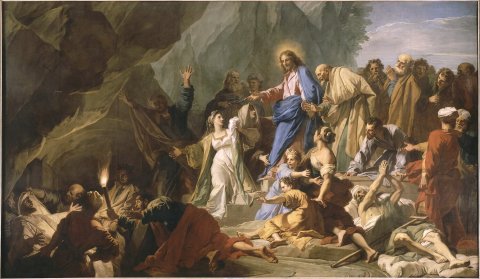
But what would you think of me, if I dared to tell you that all these resurrected heads, beautiful no doubt and of the greatest effect, are fake? [p.376] Patience. Hear me out. Does a man know he's dead? Does he know that he has risen? I defer to you, Marquis of the Valley of Jehoshaphat46, Knight of Honor of the Resurrection, illustrious Montami47, you who have geometrically calculated the place everyone will need on the great day of judgment, and who, following the example of Our Lord between the two thieves, will have the goodness to place in this critical moment on your right Grimm the heretic, and on your left Diderot the miscreant, in order to get us through to paradise, as the great lords get contraband through in their carriages at the barriers of Paris48 ; illustrious Montami, I defer to you. Is it not true that of all those who witness a resurrection, the risen one is one of the most authorized to disbelieve it? So why this astonishment, these signs of sensitivity and all those characteristic signs of knowledge of the state that preceded and the benefit rendered that painters never fail to give their resurrected? The only true expression they can have is that of a man emerging from a deep sleep or a long fainting spell. If there's any faint vestige of pleasure on his face, it's to breathe the sweetness of the air, to see the light of day again. But follow this idea, and the details will soon make you feel its full truth. Can't you see how this weak and vague action of the Risen One, carried towards heaven and distracted from those present, will make their joy and astonishment energetic? He doesn't see them, he doesn't hear them; his mouth is half-open, he breathes, he reopens his eyes to the light, he seeks it: yet the others are as if petrified.
I have a brand-new Lazarus Resurrection in my head. Bring me a great master, and we'll see. Isn't it amazing that among so many witnesses to the prodigy, there isn't one who turns [p.377] thoughtful, attentive eyes on the one who performed it, and seems to say to himself: What devil of a man is this? He who can give life, can just as easily give death... Not one who dared to make one of the sisters of the Risen One weep with joy; not one of the parents who fell into weakness! Let a great master be brought to me incessantly, and if he responds to what I feel, I offer you a Resurrection truer, more miraculous, more pathetic and stronger than any you have yet seen.
On your way back from Saint-Martin-des-Champs49, don't forget to pay a visit to Saint-Gervais, and see there the two paintings of the Martyrdom of Saint Gervais and Saint Protais, and when you've seen them, raise your arms to heaven, and cry out: Sublime Le Sueur! divine Le Sueur!... Read Homer and Virgil, and stop looking at paintings. Everything in them is everything imaginable. The most meticulous observations of nature are not neglected. If he has placed two horses side by side, they kiss each other on the nose. In the midst of an atrocious scene, two animals caress each other, as if congratulating themselves on being of a different species from ours. But when a man thinks of these little things, he doesn't forget the big things. It's Madame Pernelle who, after scolding her whole family, returns scolding her servant50.
Notes
See #005928.
See #000748.
"On appelle en termes de Peinture & d'Opera une gloire, un lieu fort esclairé, une représentation imparfaite de la gloire celeste. Mignard has painted at the Val de Grace a gloire." (Furetière)
See #001811.
See #001122.
See probably #001123.
Diderot compares "our mythology", the history of the Church, its martyrs and saints, to the pagan mythology of the Greeks and Romans, also referred to further on as "the Fable".
Diderot was fascinated by the Judgment of Pâris, to which he dedicated, probably in 1763, a text found in his papers. See DPV XIII 415-417.
Euménides, or Benevolent Ones, is the euphemistic name given by the Greeks to the Erinyes, goddesses of vengeance. Diderot evokes them regularly: in the Entretiens sur le Fils naturel in 1756 (Second entretien, DPV X 111-112, 116, and Troisième entretien, p. 148-149), in De la poésie dramatique in 1758 (p. 411-2), in the Eloge de Richardson in 1762 (DPV XIII 208), in the Essais sur la peinture in 1766 (p. 376)...
Diderot here repeats a development from his article *Theosophes in the Encyclopédie, to be published in 1765.
Understand: the life of the patriarchs, from the time of the patriarchs. We call the main figures of the Old Testament patriarchs, and in the strict sense the three founders of the Jewish people, Abraham, Isaac and Jacob.
Ganymede, Phrygian shepherd abducted by Jupiter to Olympus, where he replaces Hebe as cupbearer to the gods.
The Trinity triangle, maliciously compared to a female sex...
"CARRIERE, se dit figurément en choses spirituelles, & premierement d'un beau sujet, d'une belle matiere où on peut s'exercer à écrire, à discourir. L'Histoire du temps est une belle carriere pour un Historien. ce sujet est une belle carriere où un Poëte peut exercer son genie. Donner carriere à son esprit (to give one's mind a career) means to let oneself be carried away by one's genius, or one's pleasure; to extend oneself on a subject beyond bounds; to push a praise or a mockery too far. Ces gens se donnent carriere, c'est à dire, se resjouïssent, boivent, rient, chantent, &c." (Furetière)
" Machine, (Painting.) term used in Painting, to indicate that there is a beautiful intelligence of light in a picture. We say voilà une belle machine; this painter means well the machine. And when one says a grande machine, he means not only belle intelligence de lumieres, but also grande ordonnance, grande composition." (Encyclopédie, tome IX, 1765, p. 798a)
Episode from Genesis. Joseph, in Egypt, was sold as a slave to Putiphar, Pharaoh's minister, and soon became his steward. Putiphar's wife tries to seduce him...
See notice #011283. The collection of prints after the most beautiful paintings in Dresden's Royal Gallery was published in several volumes from 1753 to 1757. Diderot visited the gallery on his return from St. Petersburg in 1774.
" Gorge, also means a woman's breast. Sinus. Honest women must be careful to hide their gorge. A gorge well trimmed, a gorge flat. A string of pearls adorns well a beautiful gorge." (Trévoux Dictionary, 1738-1742)
In revenge for being rejected by Joseph, Putiphar's wife accuses him to her husband of having tried on her what she actually tried on him.
By fleeing, he mortally offends his master's wife; by staying, it's his master he risks betraying.
"Agony, is figuratively said in Morality of the mind, when it suffers from great labors or inquietudes. This news has put his mind into a mortal agony." (Furetière).
N'a eu garde de: s'est bien gardé de. In fact, Joseph is still expressing embarrassment and modesty in this scene.
" Prevent, v. act. & n. To be the first to do the same thing; to win the lead in racing games. Celuy qui previent, who arrives first at the goal, takes the prize. In quarrels, those who prevent, who strike first, have the advantage of making the others run. It is fastidious to let oneself prevenir in matters of civilitez. He prevenu the hour of the appointment, he arrived there first." (Furetière)
Index of Diderot's repeated visits.
Pernéty, in his Dictionnaire portatif de peinture, defines magic as follows: "Term used by metaphor in painting, to express the great art of representing objects with so much truth, that they create illusion, to the point of being able to say, for example, of complexions, this arm, this body is indeed flesh. " What's magical is that it looks so real...
Ambivalence of the screen, hiding and showing.
God's intervention.
"On dit en Peinture, qu'un ouvrage est dur & sec, lors qu'il y a peu d'adoucissement, d'union entre ses parties, que les couleurs n'en sont pas bien nuées." (Furetière. Nuées pour nuancées.) A hard color is a raw color, which clashes with its surroundings.
Grimm intervenes here in Diderot's text (in italics).
Diderot doesn't have the paintings in front of him when he writes. He has to remember them at home, in his imagination.
" Harmonic, adj. Mathematical term. Harmonicus. Proportion harmonic. See Proportion. Progression harmonic, is when taking three terms, which immediately follow each other, we find that the greatest is to the smallest, as the difference of the greatest & the mean, is to the difference of the mean & the smallest. [...] Division harmonic; in terms of Music, is a division of the octave, where the fifth is below the fourth, & serves it as a base." (Dictionnaire de Trévoux) Diderot substantiveizes and transposes a term from mathematics and music to optics and painting.
Chemistry term, see in the Encyclopédie Venel's article (III, 1753, p. 270a).
The painter's style would stem from his way of solving the problem of the proximity of colors on the canvas.
" Canevas, s. m. Large & tight canvas used to line pourpoints & skirt bodies to keep them in condition. This word comes from cannabaceus, which was made of cannabis. [...] We figuratively call canevas, the first words we give, on which we compose an air, to make more regular ones afterwards. It is also said of the memoires one gives to write some work, & to reduce it to a more polished state, as a Panegyrique, a Histoire particuliere, an outline of a Poëme, of a Roman. Mezeray made the outline of the Academie's Dictionaire." (Furetière. Cannabis, or hemp, was used to make the coarsest canvas.)
One aune measured 1.18 m.
This passage has been reconciled with Burke, A Philosophical Enquiry into the Origin of our Ideas of the Sublime and Beautiful, London, 1757.
The painting was hung after the booklet was printed, where it does not appear. It is therefore not numbered. There were no explanatory labels at the Salon indicating the names of the artists and the titles of the paintings.
The raising of Lazarus is one of Jesus' miracles recorded in the Gospels. When he arrived in Bethany, Lazarus had been buried for four days. Jesus has the tomb unsealed and orders "Lazarus, come out!" Immediately, the dead man rises, despite the bandages with which he is swaddled.
Poussin didn't paint any Resurrection of Lazarus, we only know of one drawing by him on this subject (#020635). Diderot owned a print after the Esther and Ahasuerus (#000968).
Poussin had worked particularly on the weakening and degradation of the effect as one moves further away from the event. See the Paysage avec un homme tué par un serpent, also known as Les effets de la terreur (#000961), which Diderot mentions twice in the Salon de 1767.
See notice #000748.
"Flat, figuratively said in moral things, of what is simple, vulgar, which is not elevated, lively & piquant. This man has a very flat mind, a very cold & flat stile. This thought is flat, vulgar.
Plat, also means, Low, poor, confused. This Merchant has made great losses, he is now quite flat. We made him as flat as a bug. When this reproach was made, he was very flat, he had a very flat nose. C'est un gros pied plat, un gueux, un rustre." (Furetière)
See notice #004585.
See notice #004079.
See notice #000737.
" The Valley of Josapahat. It is spoken of in the Prophet Joel III. 2. and 12. I will assemble all the peoples, & bring them to the valley of Josaphat, where I will enter into judgment with them, concerning Israel, my people & my inheritance. [...] The valley of Josaphat was between the city of Jerusalem & the Mount of Olives [the Mount of Olives]. [...] Saint Jerome believed that the Last Judgment would take place there. [...] Others [...] take these words valley of Josaphat for appellative names, meaning the valley of God's judgment. [...] Now wherever the Last Judgment takes place, this place will always be in this sense the valley of Josaphat." (Trévoux)
Didier-François d'Arclais de Montamy, first butler to the Duc d'Orléans, a friend of Diderot's since at least 1755, receives him at the Palais-Royal, where he shows him his master's extraordinary painting collection. Montamy is a contributor to the Encyclopédie. A good Christian, he is here ironically called upon as an intercessor for his miscreant friends...
The octroi gates that surrounded Paris charged customs duties on everything that came in and out. But the carriages of the great lords were neither searched nor even opened: they smuggled in all sorts of things, and for example copies of the banned E,cyclopédie...
... where Jouvenet's Lazarus can be found.
End of the first scene of Tartuffe:"Giving a blow to Flipote. Come on, you, you're dreaming, and baying at the crows.| God's day! I know how to rub your ears. Let's walk, gaupe, let's walk."
Les Salons de Diderot (édition)
Archive mise à jour depuis 2023
Les Salons de Diderot (édition)
Salon de 1763
Préambule du Salon de 1763
Louis-Michel Vanloo (Salon de 1763)
Deshays (Salon de 1763)
Greuze (Salon de 1763)
Sculptures et gravures (Falconet, Salon de 1763)
Salon de 1765
La Chaste Suzanne (Carle Vanloo, Salon de 1765)
Boucher (Salon de 1765)
La Justice de Trajan (Hallé, Salon de 1765)
Chardin (Salon de 1765)
La jeune fille qui pleure son oiseau mort (Greuze, Salon de 1765)
La Descente de Guillaume le Conquérant en Angleterre (Lépicié, Salon de 1765)
L'antre de Platon (Fragonard, Salon de 1765)
Sculpture (Salon de 1765)

